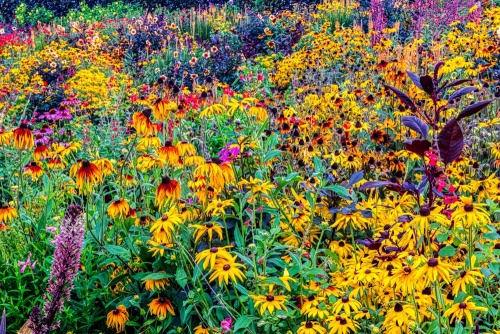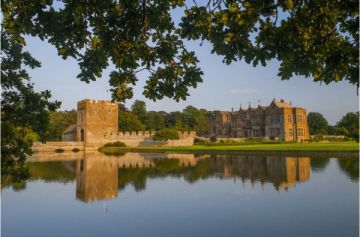
A popular pottery shop in an idyllic Cotswold village is not the first place you would look to find one of England's most appealing small gardens, but the Aston Pottery Garden surprises and delights. The grounds of Aston Pottery have been transformed to create a vibrant, colourful garden that is open to visitors throughout the year.
Aston Pottery opened its doors in 1996, selling hand-decorated pottery. The first shop was housed in a Victorian milking and calving shed, but the garden was begun in 2009 by the owner, Stephen Baughan, aided by volunteers.
The first garden border was begun in 2010, and over the intervening years the garden has grown to include six striking borders. These are, in no particular order, the Great Perennial Border, the Tropical Border, the Dahlia Border, the Annual Border, the Hot Bank, and the Pleached Hornbeam Walk. Plants are arranged in descending height order from highest at the back to lowest at the front.

Sunflowers abound. According to Baughan, they are planted first but sewn last. It takes the gardening team six hours to plant the sunflowers and another three full days to plant the rest of the seedlings.
Tropical Border
Based on plants with vibrant red, green, and purple colours. Featured plants include banana plants, ricinus, and canna.
Great Perennial Border
Based around perennial plants such as penstemon, phlox, delphinium, helianthus, inula, eupatorium, aster, rudbeckia, and helianthus.

Dahlia Border
As its name suggests, this richly-coloured border is based around dahlias - over 132 varieties!
Hot Bank
Bounded by a row of purple beech, this lush, deep bank is strong on yellows and oranges, with special attention to species like kniphofia, echinacea, penstemon, and Eremus lilies.
Annual Border
Running parallel to the hornbeam walk, the annual border holds over 120 different species of annuals and over 6,000 plants. Species include heliotropium, ageratum, salvia, aster, tithonia, French African marigold, helianthus, rudbeckia, and antirrhinum.
The Annual Border has been featured in major magazines such as Gardens Illustrated, The English Garden, and RHS The Garden. It has also been shown on BBC's Gardeners World. It is perhaps the finest display of annuals anywhere in Britain and is planted to be at its best in August.

Pleached Hornbeam Walk
This avenue consists of parallel borders based around 72 hornbeam trees which will, over the course of 15 years, grow together to form an arched outdoor room. The walk includes 2,000 plants including asters to alliums. The Pleached Hornbeam Walk is at its colourful best between April and November.
The gardening team plants over 8,500 plants each year, arrayed in the six different border areas. Everything on show is propagated and grown on-site.
In addition to the garden, it is well worth visiting the Aston Pottery shop, which has been voted one of the top twenty shops in Britain. The shop was built using over 26,000 handmade bricks, reflecting Aston's legacy as a centre for brick-making. The shop features freshly-baked cakes, breads, and quiches.

Visiting
Our family visited Aston Pottery Gardens on a sunny day in late August. At least, the day began sunny, but a sudden summer shower made us shelter under the arch of the hornbeam walk. Before and after the shower, though, exploring the garden was an absolute delight.
Though the Annual Border gets most of the plaudits from gardening magazines, what struck us most was the Hot Border, with its extraordinary wealth of reds, yellows, and oranges. We took hundreds of photographs and we suggest that you bring your camera, as you will certainly want to do the same!
Aston Pottery Garden is open to visitors throughout the year whenever the pottery shop is open.

Getting There
Finding the garden is extremely simple. Aston Pottery is located on the B4449 between Aston and Bampton, at the western edge of Aston village. It is signposted from the crossroads at the centre of the village. There is a large, free parking area.
About Aston Pottery Garden
Address: The Stables, Kingsway Farm, Aston,
Oxfordshire,
England, OX18 2BT
Attraction Type: Garden
Location: On the B4449 at the western edge of Aston.
Website: Aston Pottery Garden
Location
map
OS: SP337029
Photo Credit: David Ross and Britain Express
NEARBY HISTORIC ATTRACTIONS
Heritage Rated from 1- 5 (low to exceptional) on historic interest
Bampton, St Mary's Church - 1.6 miles (Historic Church) ![]()
Buckland, St Mary - 2.3 miles (Historic Church) ![]()
Black Bourton, St Mary's Church - 3.3 miles (Historic Church) ![]()
Clanfield, St Stephen's Church - 3.4 miles (Historic Church) ![]()
Longworth, St Mary's Church - 3.6 miles (Historic Church) ![]()
Witney, St Mary's Church - 4.1 miles (Historic Church) ![]()
Witney Bishop's Palace - 4.1 miles (Historic Building) ![]()
Cogges Manor Farm - 4.4 miles (Museum) ![]()
Nearest Holiday Cottages to Aston Pottery Garden:
Bampton, Oxfordshire
Sleeps: 13
Stay from: £3300.00 - 13416.00
More self catering near Aston Pottery Garden












